Cultural Tourist Attraction Potential Development guideline for province
DOI:
https://doi.org/10.14456/rcmrj.2021.241201Keywords:
Guideline potential development, Cultural tourist attraction, Surin ProvinceAbstract
Objectives of study are 1) to study the development of cultural tourist attraction in Surin province. 2) to study the problem of Surin’s cultural tourist attraction. 3) to purpose the guideline to develop tourist attraction potential in Surin. The methods used in this research are discovering, observation, interviewing, group chat, and academic meetings. There are 93 samples from four cultural tourist attraction ; which are Ban Ta Klang, Ban Phumpone, Wat Khaosala and swamp eel, jasmine rice and red cross festival by using purposive sampling method.
The results of the study were 1) In the development of cultural tourist attraction in Surin, the government sectors had supported the training for community. They created tourist management committee members in the community. People who are in the community can be in tourist management along with their lifestyle. And the community’s management can truly respond to community’s needs. 2) There were few problems in the cultural tourist attraction in Surin; Homestay hosts have problem with communicating foreigners with international language. They do not have enough translator and effective management in homestay. 3) The way of developing potential cultural tourist attraction can be divided into three aspects; development guideline general way of development, way of development from tourists’ needs and way of potential development in cultural tourist attraction. Lastly, the solutions are divided into three ways; tourist’s perception (attracting tourist), tourist carrying capacity and management.
Downloads
References
Department of Community Development. (2020). Service: One Tambon One Product. Retrieved from https://surin.cdd.go.th/service/one-tambon-one-product (In Thai)
Phanratanasil, W. (2008). A Study of a Philosophical Operational Model School Sufficiency Economy: Multiple Research, Case Studies. (Master's Thesis, Chulalongkorn University) (In Thai)
Ratchakrit, T. (2019). Management concept. Retrieved from https://th.hrnote.asia/orgdevelopment/190419-management-concept (In Thai)
Sarawadee, S. (1997). Community organization Mechanisms for solving problems and social development. Khon Kaen: Research and Development Institute. Khon Kaen University. (In Thai)
Suansri, P. (1997). Tourism management with participation of people. Bangkok: Volunteer Foundation for Society. (In Thai)
Tourism Authority of Thailand. (2003). Tourism and hospitality. Bangkok: Thai Union Graphics. (In Thai)
Tourism Development Plan No. 2. (2020). 2nd Edition of National Tourism Development Plan (2017 - 2021). Retrieved from https://www.thai-german-cooperation.info/admin/
uploads/publication/1be798cb24ee07703c498fcd47cbba4den.pdf (In Thai)
Waiapa, S. (2010). Development of Tourism Business Administration by Ban Sop Win Community, Mae Win Sub-district, Mae Wang District, Chiang Mai Province. (Doctor of Philosophy Thesis, Mae Jo University). (In Thai)
Yospakorn, N. (2004). Management of travel companies that affect the satisfaction of tourists. : A case study of Phra Nakhon Si Ayutthaya Province. (Master of Business Administration Thesis, Phranakhon Si Ayutthaya Rajabhat University. (In Thai)
Downloads
Published
How to Cite
Issue
Section
License
1. Articles, information, content, images, etc published in the “Community and Social Development Journal” are copyrighted by the Community and Social Development Journal, Chiang Mai Rajabhat University. In order to properly distribute the articles through print and electronic media, the authors still hold the copyright for the published articles under the Creative Commons Attribution (CC BY) license, which allows the re-distribution of the articles in other sources. References must be made to the articles in the journal. The authors are responsible for requesting permission to reproduce copyrighted content from other sources.
2. The content of the articles appearing in the journal is the direct responsibility of the article authors. The editorial board of the journal does not necessarily agree with or share any responsibility.














